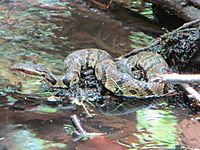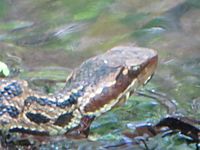Eastern cottonmouth facts for kids
Quick facts for kids Eastern cottonmouth |
|
|---|---|
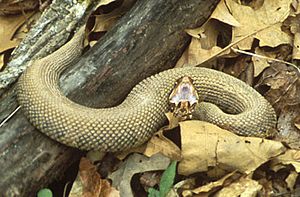 |
|
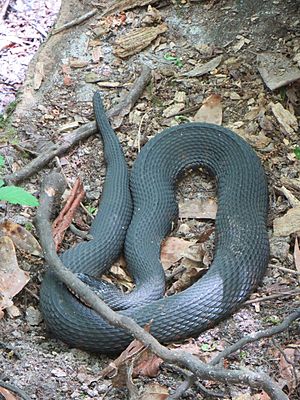 |
|
| A. p. piscivorus, pale and dark forms | |
| Scientific classification |
|
| Kingdom: | Animalia |
| Phylum: | Chordata |
| Class: | Reptilia |
| Order: | Squamata |
| Suborder: | Serpentes |
| Family: | Viperidae |
| Genus: | Agkistrodon |
| Species: | |
| Subspecies: |
A. p. piscivorus
|
| Trinomial name | |
| Agkistrodon piscivorus piscivorus (Lacépède, 1789)
|
|
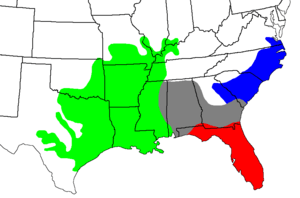 |
|
| Geographic variation of A. piscivorus
A. p. piscivorus Intergradation
|
|
The Eastern cottonmouth (scientific name: Agkistrodon piscivorus piscivorus) is a type of venomous pitviper. It is one of three subspecies of the Agkistrodon piscivorus snake. These snakes live in different parts of the southeastern United States. People also call them cottonmouth moccasins or water moccasins.
Contents
Physical Description of the Eastern Cottonmouth
Eastern cottonmouths are usually between 20 and 48 inches (51 to 121 centimeters) long. Some have grown to be as long as 74.5 inches (189 centimeters)! They have a heavy body and are mostly dark in color.
Color and Pattern Changes
Younger cottonmouths look different from older ones. They have red to brown bands across their bodies. The background color is a lighter brown. These bands have spots and speckles. Their tails are a bright sulfur color. As the snakes get older, their patterns become darker. Many adult cottonmouths are completely black.
Special Features of Their Head
The scales on their bodies are keeled. This means they have a ridge down the middle, making them feel rough. The snake has wide, dark stripes on its face. These stripes help to hide its eyes. When you look at the snake from above, you cannot see its eyes. Their pupils are like a cat's eye, with a vertical slit.
There is a deep pit between the snake's eye and its nostril. This is called a facial pit. Pit vipers use these pits to sense heat. This helps them find warm-blooded prey, even in the dark.
Where Eastern Cottonmouths Live
You can find the Eastern cottonmouth in the southeastern United States. They live in southeastern Virginia. They are also found along the Atlantic Coastal Plain and the lower Piedmont region of North and South Carolina. This includes the riverbanks, peninsulas, and islands along the Atlantic coast. Their range also extends west across Georgia. You can see their full range on the map in the infobox.
See also
 In Spanish: Boca de algodón para niños
In Spanish: Boca de algodón para niños


